SOFT PLASTICS
TOP 10 COLOUR COUNTDOWN
By Mark Kitteridge
I’ve been a hardcore soft plastics user for many years now, and in the process I’ve enjoyed strong associations with the two most popular brands here in New Zealand, Gulp! and Z-Man.
The great thing about Gulp! and Z-Man is just how completely different they are, potentially offering anglers 180-degree solutions to the everchanging fishing puzzles encountered. I think it’s fair to say that other brands like Daiwa Bait Junkies and Catch Livies occupy the space in between them and can also prove very worthwhile, but limited use means I cannot comment on them with as much authority.
For example, if requiring a biodegradable material that sinks relatively quickly and which has a longlasting, very attractive scent, then Gulp! cannot be beaten. It is also the only product that can be nibbled right down to a solid body chunk (especially the 7” jerk shad and 6” grub) yet can still be attractive enough for a decent snapper to eat it!
However, this product’s relative fragility can be a major disadvantage when species such as leatherjackets, wrasse and squid are present. This is where Z-Mans come in (with Bait Junkies and Livies proving approximately threequarters as tough), as they can withstand sharp teeth for much longer.
Also, the materials they are made of, such as Elaztech (Z-Man) and thermoplastic elastomer (Bait Junkies and Livies), tend to possess more flexibility and buoyancy, which can come in handy at times, such as when a slower descent or a tail-up presentation on the bottom is desired. It is worth noting that Elaztech is not actually a plastic and contains no potentially harmful phthalates.
Whatever the brand choice, shape and size though, it’s obvious that a specific colour or colour combination can be pivotal to soft plastics success, and that’s why so many options are available at fishing tackle stores.
Just why a certain colour (or colours) works so well at one time but not the next is a hot topic of debate. I believe this comes down to several factors, including the amount of water clarity or turbidity, how dark or light it is, the depth of water being fished, and what the snapper are feeding on (or would like to eat if the opportunity arose).
Having used most of the colours on offer over the years, I suggest the following 10 colours/combos can provide the answer to the majority of scenarios encountered.
10) Fluoro Green and Orange (Lime Tiger Glow)
There are a lot of Lime Tiger fans out there, and I believe this is due to the marked contrast between the two colours incorporated, perhaps also accompanied by the lumo element. It’s a proven combo when the conditions are rather murky or gloomy.
9) Yellow and Red (Curried Chicken/ Bleeding Banana)
This colour combination in the Gulp! 6.5” Nemesis and 5” Crazy Legs saw me enjoying massive success a few years ago, including some real monsters – talk about bloody effective! More recently though, it seems to have become a very hot or cold option, but murky conditions can still see it performing at its best.
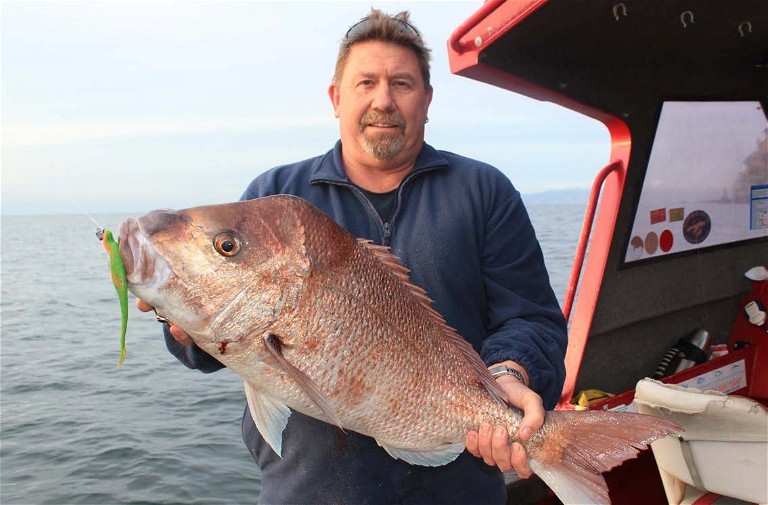
Bright green and orange is a well-proven combination, probably due to its high visibility and contrast.
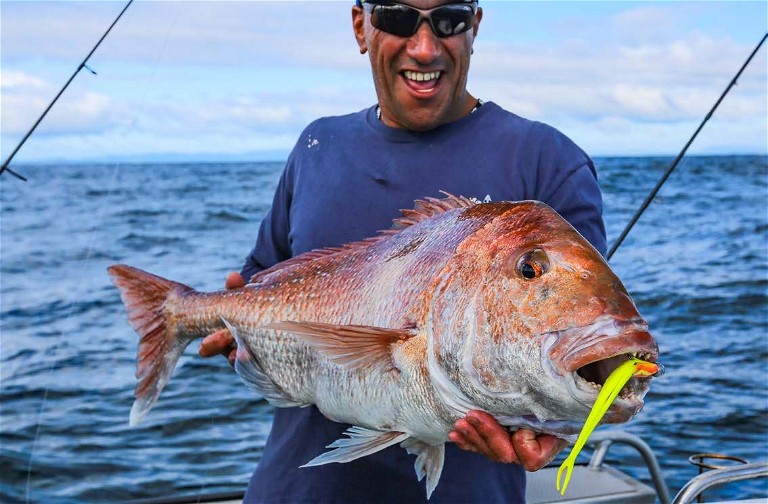
Yellow and red is a rare combination in the underwater world, and maybe that’s why it gains so much attention!
8) Brown (predominantly known as New Penny, along with close ‘cousins’ Pumpkinseed/Mud Blood)
I’m guessing the secret to New Penny (especially) is that many tasty critters on the bottom are brownish in colour, including mantis shrimp, baby crayfish, flounder, greasy prawns, etc. and squid often have a brown appearance, too. New Penny is a very consistent performer, especially for anglers targeting snapper snuffling around along the seafloor. The smaller paddle and grub tails in 4” and 5” are particularly effective.
7) Red and Fluoro Green (Nuclear Chicken/Nuked Chicken)
This is arguably the most famous softbait colour of all, and it’s probably due to a variety of factors, including two highly contrasting colours, fluorescence, and luminescence. This clever combination sees the Nuclear Chicken performing in all sorts of conditions and depths, especially jerk shads and grub tails in 5-7” sizes. Consequently, it’s the go-to colour combo for many softbaiters.

The great thing about brown is that it is suggestive of many tasty sea creatures.
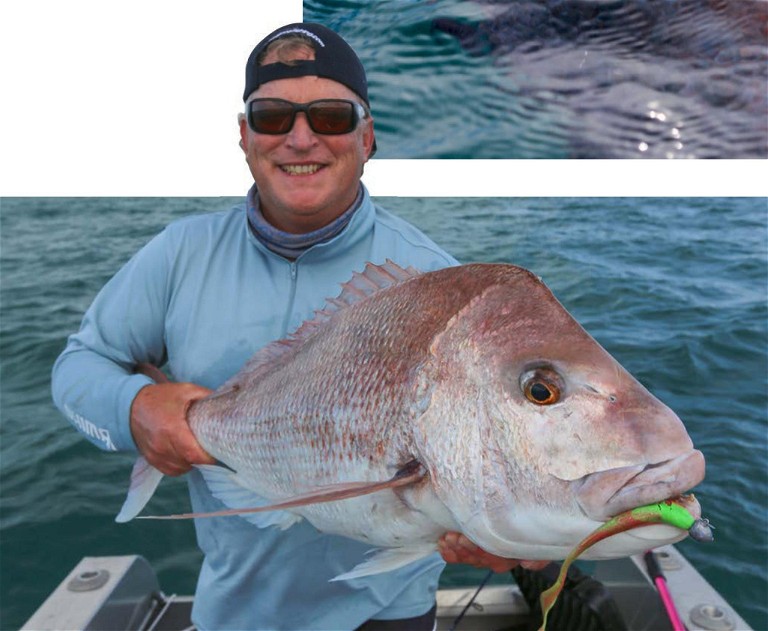
Red and green is arguably New Zealand’s most popular softbait colour, and there’s no doubting its effectiveness in all water depths, but the catchy Nuclear Chicken name helps, too!
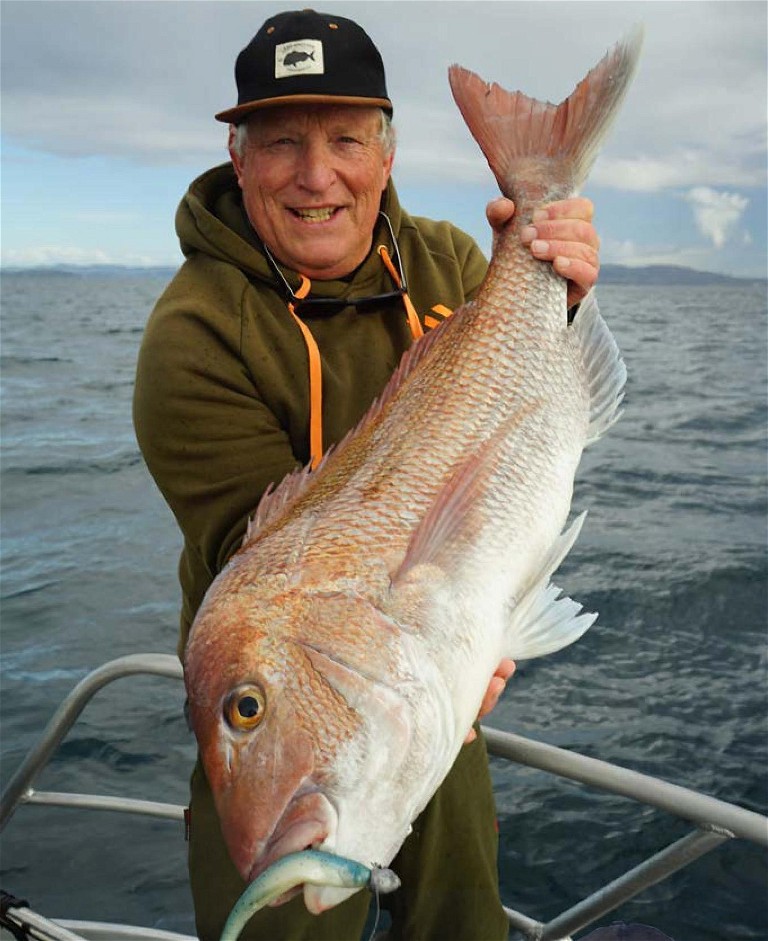
Blue and pearl represent a pilchard, so no wonder it’s a winner.
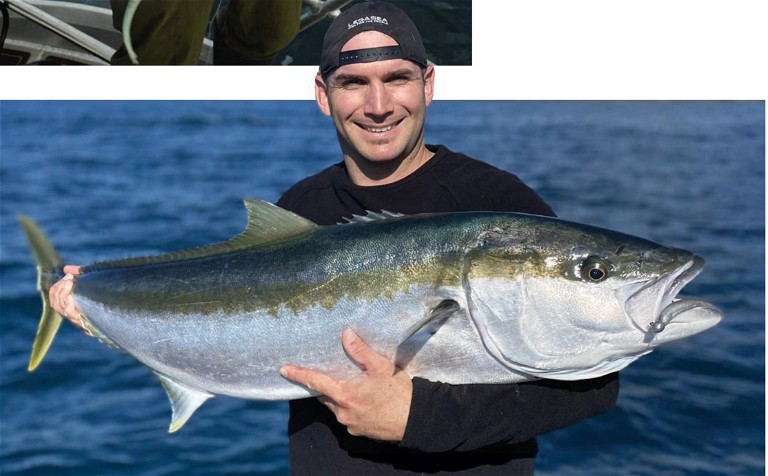
Silvery grey might not seem an especially stimulating colour, but the fish sure like it!
Photo: Josh Darby.
6) Blue and Pearl/White (Sapphire Shine/Blue Pepper Neon/Disco Cisco/ Nuked Pilchard)
How can you go wrong with imitation pilchard colours? I have done very well on snapper and kingfish with this colour combo in 5-7” jerk shads, in depths ranging from three to 70 metres. Another colour that demands focus on the drop, so use the bare minimum weight jighead needed to get down to realise its full potential!
5) Silvery Grey and Pearl (Silver Mullet/Smoky Shad/Shiner/Ayu)
Whenever I see this colour, I think of my good buddy John Eichelsheim, who always whacked one on when unsure of what to use – and so often scored big as a result! It’s obviously a baitfish imitation – perhaps a piper or mullet – and a real ‘searcher’ pattern. However, I didn’t really climb on board this particular train until I tried Smoky Shad, and wow, what a winner on both snapper and kingfish in all sizes and shapes, especially in relatively clear water!
More recently, this grey and silver combination has proved stunningly effective when fishing the anchovy schools in 3-4” sizes.
4) Bright Orange (Orange Belly/ Red Fleck/Atomic Sunrise
Just why fish would like to eat something that looks as if it’s made from Fanta is beyond me. Possibly its high visibility plays a part, especially as this colour can also possess plenty of UV reflective qualities as well. I’ve enjoyed great success with this unlikely colour in all manner of depths, and in murky or clear water. Fishers might be interested to know it can even prove lethal in the ‘pea soup’ Kaipara shallows! This is another colour that’s attracted excellent results amongst the anchovy activity, especially the Bait Junkie 3.2 Minnow version, possibly as it stands out so vividly from all the other small fish!
3) Yellow and Brown (Curried Chicken/Bruised Banana/Banana Split)
If orange is an unlikely colour for success, then yellow would have to be even more so (especially as the Z-Man version has no UV reflective qualities, yet it is arguably up there with Nuclear Chicken as the most famous softbait colour combo. Yellowbrown really is a must-have colour, enticing snapper of all sizes to bite on a regular basis. Go figure!
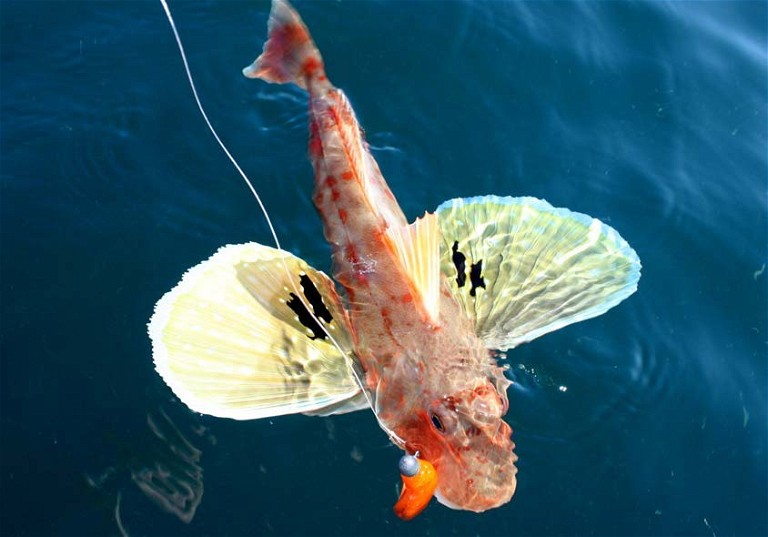
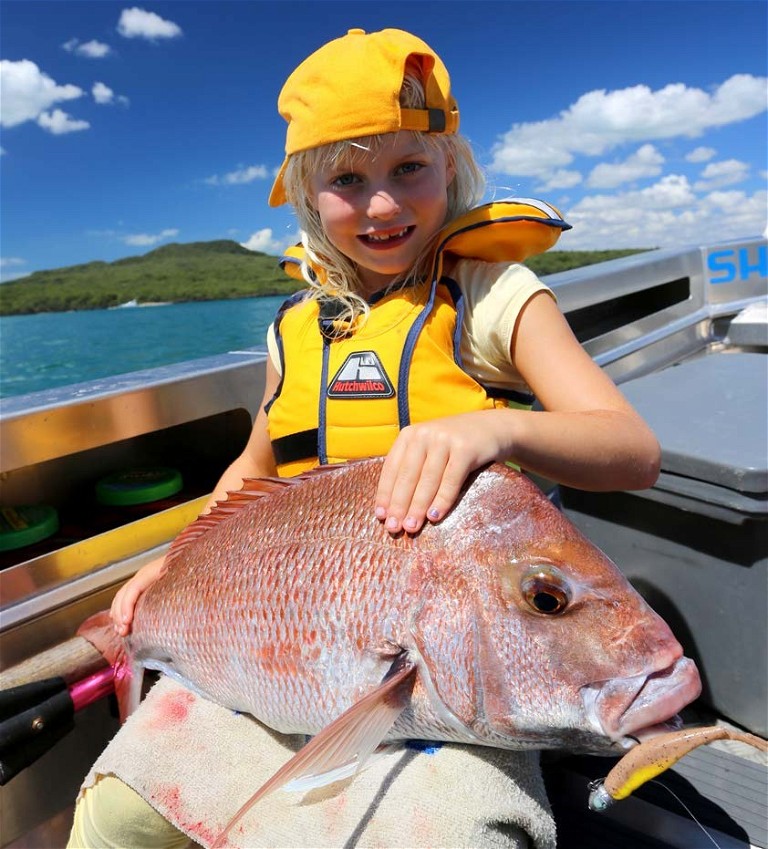
There’s something about yellow and brown that presses the right buttons in predatory fish.
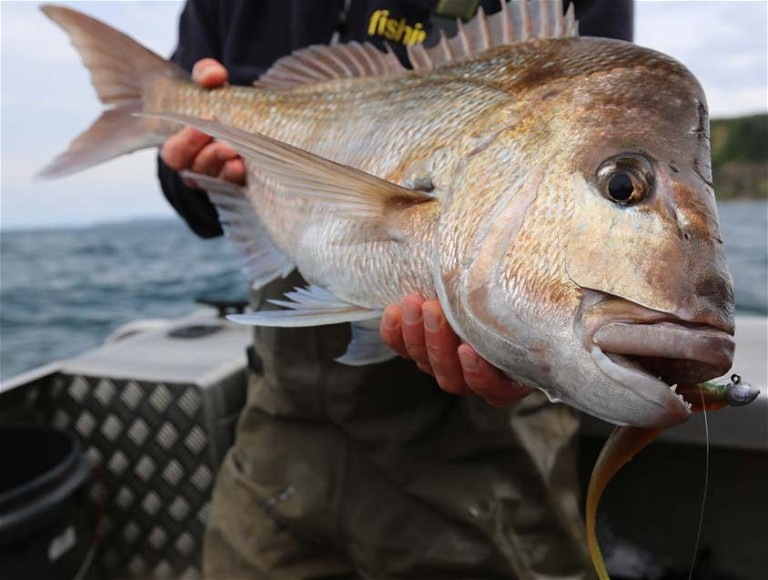
This green lure looks very unappetising, but hold it up to the light or shine a UV torch on it and it’s a very different story.
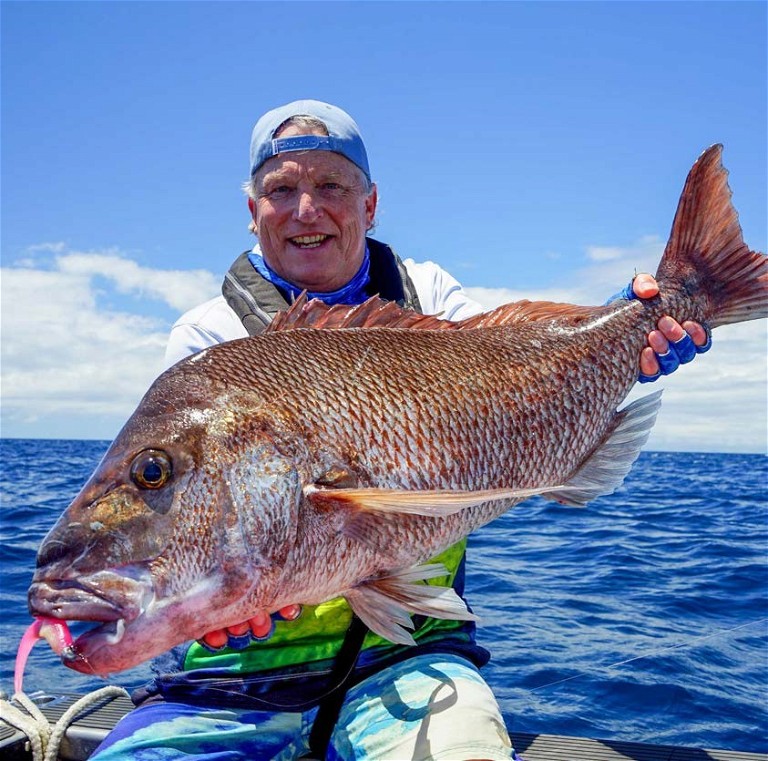
The bright fluoro pink often has high UV properties and performs best in water depths to 25/30 metres, while the lumo version takes over in deeper waters around 30-70 metres.
2) Green (Motor Oil/Camo/Better Oil)
Although all the main brands have versions of this colour and all can be very effective, the Z-Man’s ‘green snot’ version is the one I’ve used the most. Interestingly, this one looks a plain dark green in the pack, but when held up to the light it’s transformed into a much more orange colour – and the amount of UV reflectiveness is impressive, too. In fact, the results proved so consistent that I didn’t change this colour for over two years… until another colour kicked it from its perch.
1) Pink and Pearl/ White (Pink Shine/ Laguna Shrimp/ Coconut Ice/ Creaming Soda)
My initial reluctance to use pink is ridiculous; I suspect it was influenced by an association with Barbie, especially in its pinkest incarnations. More fool me. After all, it wasn’t so long ago that pink and white adorned all the best jigs, and it’s starting to happen again, rivalling orange for popularity. Whatever, bright pink has been a very consistent and effective performer for some time now, and in all sizes of soft plastics, from 2.5-7”. Note though, that the bright pink seems to perform best in shallower waters to 30 metres, while those incorporating lumo take over from there on downwards.
So there you go, my current ‘Top 10’. But one thing’s for sure, this list won’t stay like this forever…